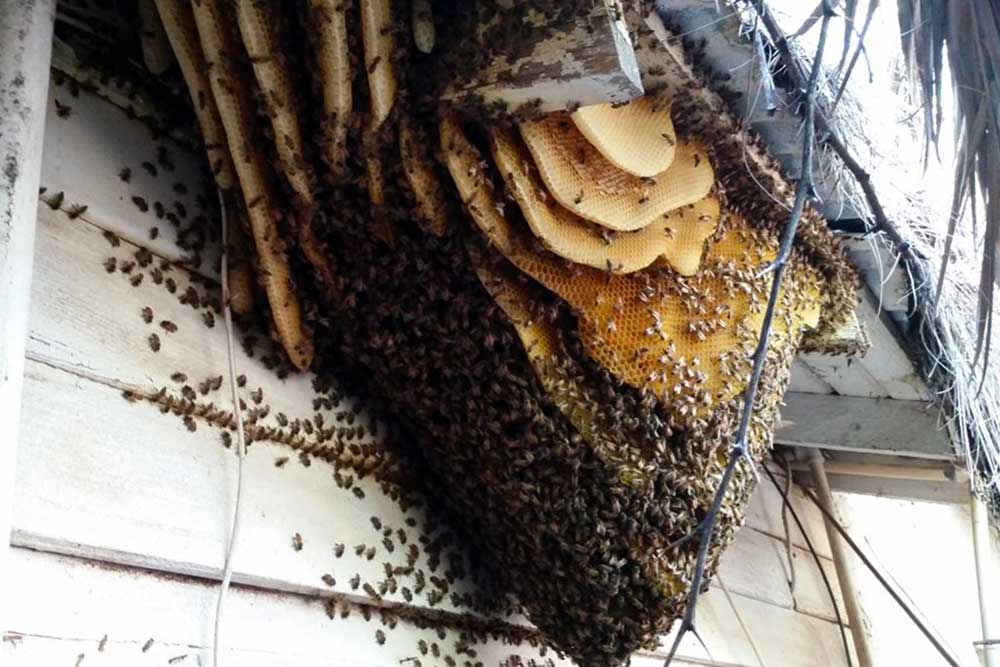
Bee Colony Under the Eave of a Chandler Home
This photograph shows a Bee Colony Under the Eave of a Chandler Home before bee removal. After 20 years in the bee removal business, we’ve seen this situation many times. As you can see, the bees have built a large amount of honeycomb beneath the second story eave. Agitated prior to our arrival, the bees prepared to defend their colony in large numbers. In this case, the honeycomb has grown to a very large size, much larger than we usually see. We have the expertise to safely and cost effectively serve you to resolve these and all other bee problems. Below we talk about removing an established bee colony that built honeycomb under the roof eaves and inside the attic space of a Chandler, Arizona home .
Contact us now and we would be honored to serve you. We have provided Chandler bee removal services for 20 years and can solve any bee problem you may have. We are open 24 hours per day, 7 days per week, 364 days per year.
Bee Removal Services
Live Bee Removal
Live bee removal and relocation is generally possible depending on the temperament of the bees and the safety of people and pets in the surrounding area. In this case, we were able to humanely remove the bees and relocate them to our east valley apiary.
When we perform live bee removal, we carefully collect the bees from the surface of the honeycomb. We use special techniques to keep the bees calm while collecting them into a transport box. After removing the bees from the honeycomb, we remove the comb and scrape the area free of wax. Then we deodorize the area to prevent re-infestation. If needed, we offer repair services in the bee removal location to return our customer’s property to tip-top condition.
Bee Extermination
Bee extermination should be avoided when possible because bees are valuable pollinators. However, sometimes, extermination is necessary to protect the safety of people and pets.
Sometimes we find that the bees have build comb under the eave and, surprisingly, in the adjacent attic space. This generally happens when the bees feel crowded inside their attic location. If crowed, they occasionally overflow and build comb under the eave adjacent to their attic comb. As part of their hive, they protect it accordingly.
Homeowners are sometimes unaware that they have a bee infestation until it has grown very large. Sometimes homeowners are alerted by a neighbor because of their view of the home. Other times the bees make their presence known when they become territorial and begin stinging to keep people away. When this happens, their behavior will generally become worse over time. We strongly recommend having bees removed as soon as they are noticed. Removing a swarm of bees when they arrive, before they have time to build honeycomb, costs less than waiting until they build honeycomb.
Are Bees in Chandler AZ Africanized?
We often think of this stinging bee behavior as aggressiveness, but the bees are just trying to protect the area around their home. Nonetheless, since virtually all “wild” honeybees in Chandler and most of Arizona have been Africanized since before the year 2000, bee colonies frequently display a very strong defensive behavior that often results in their victims getting anywhere from a few stings to hundreds or thousands of stings. Usually, these sting incidents are minor, but if a person is allergic to bee stings or if they get a large number of bee stings, it can result in an ambulance ride to the hospital.
Honeybee Behavior
Bees have the ability, under the right circumstances, to build a lot of wax honeycomb in a surprisingly short period of time. The size of honeycomb produced by honeybees depends on factors such as:
- population of the original swarm,
- size of the area they occupy,
- season when the swarm arrived, amount of available food,
- vigor and health of the bees,
- and age of the queen.
A large swarm (25,000 to 35,000 bees) has many bees of different ages to perform all the varied tasks within the colony thereby allowing many bees to forage for nectar and pollen. It takes eight pounds of honey to produce one pound of wax honeycomb, so only large hives can produce a large amount of comb in a short time. Imagine this, it takes two million trips to flowers to produce one pound of honey! In the case of the photo shown, there is about four pounds of wax, which took about 32 pounds of honey to make, or about 64 million trips that the bees in this colony made to flowers for nectar.
Hives of this size are most common during years when there is average-to-good rainfall in December, January, and February. Rain in these months provides flowering weeds that bees use to increase their population before citrus, Mesquite and Palo Verde start blooming. Swarms that establish a new home (on your property) during the months of March or April can grow to a size of 60,000 bees and produce approximately 70 to 125 pounds of honey and wax by the end of July.
